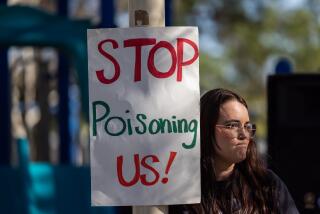The Waste That Keeps on Giving: Composting
- Share via
Question: I would like to start composting. Can you give me some guidelines? Also, I’m concerned about the odor.
J.D., Orange
Answer: Managed hot composting is a safe, relatively easy way to recycle 95% of household green waste (a general term for recyclable organic materials). When the composting ingredients are combined properly, there is no bad odor.
These necessary ingredients are carbon (the brown materials such as dry leaves and twigs), nitrogen (fresh green leaves, grass clippings, and kitchen trimmings of fresh fruits and vegetables), water and air.
Composting guidelines:
* Mix equal portions of chopped, crushed or shredded browns and greens in a 3-foot-square enclosure with air openings. A pile gets too cool if spread out.
Bins can be purchased or homemade. Decomposition works best (and faster) if the materials are chipped, cut or shredded. Large pieces of garden material will decompose--it just takes longer.
Add and mix the carbon (browns) and nitrogen (greens) in water until damp, but not wet. Within 24 to 48 hours, the pile’s temperature will rise to 140-160 degrees.
* Every three to five days, turn the pile and add water as needed. Turn the outer, cooler material toward the warmer center of the pile. This ensures that all material reaches 140 degrees for two to three days, which kills most weed seeds and pathogens.
Turning provides the air and oxygen required by the aerobic bacteria to decompose the products, hasten the decomposition and prevent the undesirable anaerobic conditions that cause unpleasant odors.
* When the temperature of the material no longer increases after turning the pile, allow two to four weeks for curing before using as an amendment or mulch. During this period the pile is still breaking down, and the compost will rob nitrogen from the soil if used too soon. The finished product is a dark, crumbly, humus material with a musty, earthy smell.
Brown (carbon) materials to use include dry leaves, branches, wood chips, other dry yard waste, shredded paper, dry wood, straw and corn stalks.
Green (nitrogen) materials to use include vegetables, fruit trimmings, grass clippings, garden trimmings and coffee grounds. Manure (rabbit, chicken or horse) is optional but is odorous and unnecessary.
Do not use diseased plants, palm fronds, ivy, succulents, pesky weeds, meat, fish or dairy products, or dog or cat manure.
Have a problem in your yard? University of California Cooperative Extension (UCCE) Master Gardeners are here to help. These trained and certified horticultural volunteers are dedicated to extending research-based, scientifically accurate information to the public about home horticulture and pest management. They are involved with a variety of outreach programs, including the UCCE Master Garden hotline, which provides answers to specific questions. You can reach the hotline at (714) 708-1646 or send e-mail to ucmastergardeners@yahoo.com. Calls and e-mail are picked up daily and are generally returned within three days.






